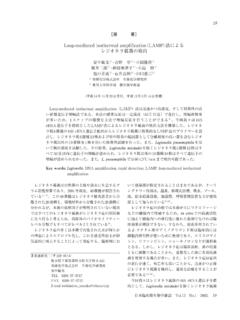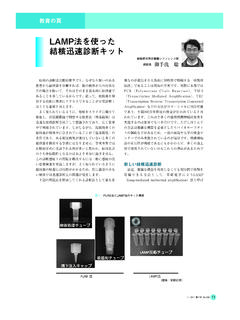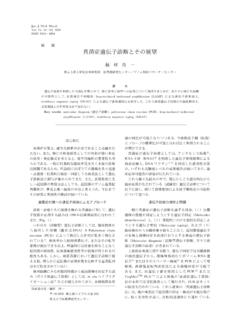Transcription of Loop-Mediated Isothermal Amplification (LAMP) - …
1 Loop-Mediated Isothermal Amplification ( lamp ): Assay Development Challenges and introduction to vs. technologies for much experience do you have with lamp assays?First Question for You!Introduction to lamp and Comparison to takes place at a single temperature a polymerase with high strand displacement activity is rapid be used for RNA templates by addition of reverse transcriptase (RT) or by using an enzyme with both RT and DNA pol activitiesLAMP: An Isothermal Amplification and to end userAdvantage of lamp : ASSURED lamp is an ideal Amplification technology for Point of Care/Point of Need assays Test platform using lamp could fulfil WHO s recommended ASSURED characteristics:Which applications are you interested in performing using lamp assays? (choose all that apply)Next QuestionFIP(Forward Inner Primer)BIP(Backward Inner Primer)F3(Forward Outer Primer) B3(Backward Outer Primer)FL(Forward Loop Primer) BL(Backward Loop Primer) lamp PrimersA Six Primer Mix Produces Optimal lamp ResultsFigure: IntermediatesGeneration of Key Stem Loop DNA StructureNon-cyclical StepsFigure: ProductsGeneration of Multimeric DNAs with Inverted Repeats During Cycling AmplificationCycling Amplification StepsFigure: WorkflowEasy with Low Complexity InstrumentationSampleHeat lysis/NA extractionAmplificationDetection5-15 min 30 minReal time or end pointLAMP vs.
2 PCRLAMP Assays are Faster, Simpler Once temperature cyclingIsothermal single 2 primersRequires 6 : Typically >1hrRapid: Typically <30 yield ~ gTypical yield ~ 10 20 amenable to visualdetectionAmenableto visual detection basedon turbidity to sample matrix inhibitorsTolerant to sample matrix be multiplexedDifficult to multiplexDetection TechnologiesLAMP Amplification Detection MethodsMultiple Choices Are Available Depending on NeedsMg PrecipitationColorimetricAgarose GelReal Time TurbidityEnd Point Analysis is Not Suitable for Optimization + + + + + + + +00 NTC1 kb L1 kb LTarget AmountDNA copies /reactionDetection by Real Time Fluorescence& TTRA Quantitative Measure of Assay PerformanceTime to Threshold (TTT)orTime to Result (TTR) provides a quantitative measure of assay performanceSignal ThresholdTTR Provides a Quantitative Parameter for Assay OptimizationTarget Amount:NTCA garose Gel VisualizationFluorescence TTR AnalysisMore quantitative resultsWhat type of nucleic acid targets do you want to detect using lamp assays?
3 (choose all that apply)Third QuestionAssay OptimizationGoals for OptimizationFaster TTR and Lower Background Signals Increased reaction speed (faster TTR) Decreased non-specific Amplification (slower TTR from Negative Control) Increased separation between Positive and Negative TTR Improved sensitivity (Detect low copy inputs)Factors for OptimizationMultiple Parameters Should be Assessed Primers (design, concentration and ratio) Enzyme (concentration) Reaction temperature Mg ion concentration Reaction pH Additives such as betaineFigure: and Choosing the Best Primer SetPrimer Design Dramatically Affects lamp QualitySeven different primer designs were tested at multiple temperaturesIllustrating the Effects of Primer Design on Assay PerformanceWinners!Winners!Additional Characterization of Primer Design #1 Sensitive with Undetectable BackgroundTesting Primer Set #1 with Varying Target AmountsIllustrating the Effect of Primer ConcentrationMaximizing the TTR Between Positive & NTC1X Primer ConcentrationsFIP & BIP: & BL: & B3: difficile target was assayed at various primer concentrationsBestEffect of Enzyme ConcentrationOptimizing Enzyme Amount Improves TTR (min)Enzyme ConcentrationC.
4 Difficile target was assayed with varying enzyme concentrations ( to )Plus Target (+):NTC (-):Illustrating the Effects of Enzyme Concentration (Amount) on Assay PerformanceIllustrating the Effects of Temperature on Assay PerformanceEffect of Assay TemperatureMajor Differences Based on Assay TemperatureDNA lamp using M13 phage as targetIllustrating the Effects of Mg2+ Concentration on Assay PerformanceDecreasing the Mg Ion Concentration Reduces Background : 4 mMB: 6 mMC: 8 mMD: 10 mMRTLAMP was carried out using MS2 target at different Mg concentrationsHigh Target #:Medium Target #No Target Control #:Mg2+ ConcentrationTime to Results (TTR)Illustrating the Effects of Buffer (Reaction) pH on Assay PerformanceReaction pH Has Less of an Effect on Positive TTRP ositiveNo target controlReaction pH Affects Background (Negative) AmplificationpH difficile genomic DNA assayed at various buffer/reaction pHPositive -RedNegative -BlackNo Target Control ReactionspH LInclusion of Betaine May Improve Assay PerformanceC.
5 Difficile TargetPositive:Negative:Improved TTRUse of DOE May Improve OptimizationSet objective(Reduce positive TTR, increase negative TTR)Select input factors([MgSO4], [KCl], [(NH4)2SO4)] etc.)Select output response(TTR)Select design(Screening design, response surface design etc.)Develop strategy(Target level, replicates etc.)Run experiments(Realtimeto derive TTR)Analyze dataFit modelInterpret modelConfirm modelDetecting C. difficile Target in Untreated and Heated Stool SamplesSample Quality Affects Assay PerformanceCrude Samples May Require Pre-treatment0102030405060 HighMediumLowNTCTime to Result (min)Target LevelUntreated Stool Sample:Preheated Stool Sample:Stool sample was either added directly to the lamp reactions or preheated at 90 C for 5 min and then added to the lamp TroubleshootingTroubleshootingExamine the Optimization Parameters Primer design Primer purity Sample matrix inhibition Suboptimal reagent conc. (Enzyme, Mg, salt, primer etc.) Suboptimal assay condition (temperature, pH etc.
6 Target contaminationSolutions to lamp Challenges: OmniAmp and LavaLAMPTMT hermostable OmniAmp PolymeraseA lamp Enzyme with RT and DNA Pol Activity Innate reverse transcriptase and DNA polymerase activity Innate strand displacement activityOmniAmp Polymerase Ideal for MDxPoint of Care and Available NowPropertyOmniAmp PolymeraseThermostability > 70 C+Strand displacement+Single enzyme based RNA or DNA detection+ Isothermal Amplification +Can be stably dried+No extraction required+ Well-suited to DNA and RT- lamp assay optimization Increased specificity and flexibility (target and reaction conditions) , a 2X lamp Master MixComing Soon! Convenient 2X master mix formulation Sensitive, specific and rapid detection of DNA targets Tolerant to crude samples Can be heated to 90 C for target denaturation, sample lysis Includes dye for real time fluorescent detection Can be freeze dried for ambient storageIf you could design the perfect lamp Master Mix product, which of the following characteristics are most important?
7 (choose your top 3)Last QuestionConclusionsLAMP Represents a Powerful Tool for Simplified, Sensitive Nucleic Acid Detection lamp is highly sensitive, specific and rapid lamp assay design tends to be more challenging than PCR due to requirements for multiple (6) long (~40-45 mer) Amplification primers Achieving robust assay performance requires assay optimization Major optimization parameters include assay temperature, enzyme conc., primer design and conc., Mg2+ conc., and additives such as betaine Use of DOE may help identify an optimal buffer composition that meets sensitivity and specificity needs An optimized lamp assay could provide point of care/ point of need assay that is economical and easy to implementResourcesLAMP Primer Design: PDF explain primer design: PrimerExplorerto design primers: lamp designer to design primers: Publication: Tech 575-9695(608) 831-90118 am 5 pm Central TimeThank You!







